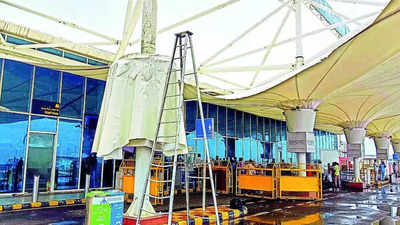- News
- City News
- rajkot News
- How rain exposed fragile infra at Rajkot International Airport
Trending
How rain exposed fragile infra at Rajkot International Airport
Rajkot International Airport, with flights to key destinations, handles thousands of passengers daily. Despite construction delays, the airport's significance in regional air travel is evident through its operational efficiency and passenger traffic.

However, no one was injured in the incident that occurred at the passenger pick-up and drop-off point outside the interim terminal building.
Preliminary investigation revealed that the canopy collapsed due to water accumulation on the top and gusty winds. No flight operations were also affected due to the incident.
The international airport is located at Hirasar, 30 km from the city, and it was inaugurated in July last year.
"The canopy collapsed due to water accumulation and heavy wind and nobody was injured in the incident. We have deployed a team to clear the water above the canopy," said Diganta Borah, airport director, told TOI.
According to the sources, the canopy is made out of a sustainable fabric using wood pulp and it's considered a high-end material known for being soft and durable.
The airport was inaugurated by Prime Minister Narendra Modi in July last year. However, since its inauguration, the airport has been functioning in a temporary building that was meant for cargo handling. The new permanent terminal was supposed to be completed by the end of Feb 2024 but it is still under construction and the new deadline has been set for Aug 15.
This greenfield airport spread over 1,025 ha was built at the cost of Rs 1,405 crore. This airport with a 3,040 m long and 45 m wide runway handles 10 to 12 flights connecting destinations like Delhi, Mumbai, Ahmedabad, Bengaluru, Pune and Goa, and 3,000 to 4,000 passengers travel every day.
End of Article
FOLLOW US ON SOCIAL MEDIA










